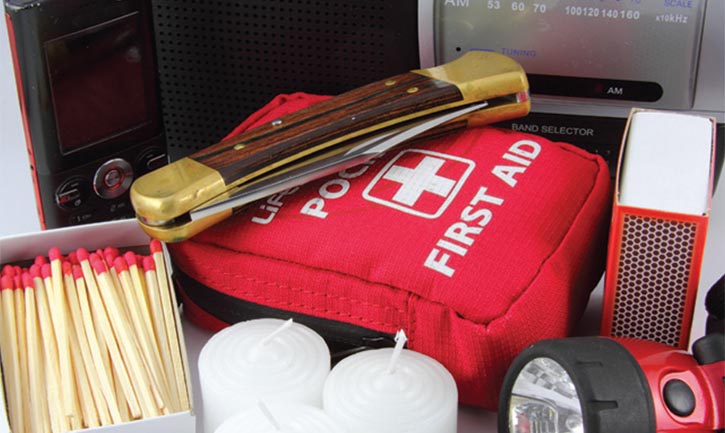
Being prepared can help keep you safe
Customers should prepare before weather threatens the area. And having an emergency plan is the best way. Always listen to local officials to learn about the emergency plans that have been established by your state and local government. And in any emergency, always pay attention to the instructions given by local emergency management officials.
Preparing your family emergency plan isn't complicated. If your family is separated when disaster strikes, having a plan in advance will help you know how to contact one another and get back together after the storm passes. A kit of basic emergency supplies and a first aid kit are easy to assemble and are smart ways you can prepare for severe weather. Remember to check the expiration dates on your supplies often and replace the expired items.
Find more useful information on ready.gov and redcross.org.
Your family plan
There are many things to consider when making your family emergency plan. Sit down with your family or friends and decide how you'll contact each other, where you'll go for safety and what you'll do during and after the storm.
- How to stay in contact: How you will contact and stay in touch with others? Text messages often work best during times of an emergency, as they can get around network disruptions when phone or voice communications are down.
- Contacts: Designate one or more out-of-town contacts, in case of emergency, so they may be reached if those closer to you cannot. Save and share all emergency contact information, so everyone knows how and who to alert.
- Location: Where you will go for safety? What you will do during and after the severe weather has passed.
- School and work: Know others’ emergency plans that may affect yours. Stay or go If relevant and time permits, decide whether you will evacuate or stay so appropriate safety measures can be met.
- Actions: Outline pre-storm actions, like filling up your gas tank, trimming trees not near power lines, clearing debris and bringing items that may blow away indoors.
- Additional considerations: When preparing your family for emergencies, it is important to consider emergency kits specific to older adults and those with hearing and visual impairments. Read more about emergency kit guidance at the National Council on Aging.
Your kit
A kit of basic emergency supplies and a first aid kit are easy to assemble and an important way to prepare for severe weather. Remember to check the expiration dates on your supplies often and replace the expired items. You can find lists from many sources to help you make your kit, including ready.gov and the American Red Cross. Your kit may include:
- Water, the American Red Cross recommends one gallon of water per person per day.
- Non-perishable food, medicine, baby supplies and pet food. Have a hand-operated can opener on hand.
- First aid kit with reference material such as a first aid book.
- Emergency equipment, such as flashlights, battery-operated radios, extension cords, emergency generators, extra batteries.
- Cellphone with charger, inverter or solar charger.
- Battery-powered or hand-crank radio and a National Oceanic and Atmospheric Administration Weather Radio with tone alert and extra batteries for both.
- Personal documents such as copies of insurance policies, identification and bank account records in a waterproof container.
- Extra cash on hand, since electrical power outages may prevent you from withdrawing money from ATMs or banks.
- Personal hygiene items and glasses.
- Spare clothing: long pants, sturdy shoes and additional clothing if you live in a cold-weather climate.
- Sleeping bag or warm blanket for each person. Consider additional bedding if you live in a cold-weather climate.
- Moist towelettes, garbage bags and plastic ties for personal sanitation.
- Matches in a waterproof container.
- Fire extinguisher, whistle to signal for help, paper and pencil.
- Wrench or pliers to turn off utilities.
- Dust mask, to help filter contaminated air and plastic sheeting and duct tape to shelter-in-place.
- Books, games, puzzles or other activities for children.
First aid kits
In an emergency, you or a loved one may suffer injuries like cuts or burns or worse. Not every injury is life-threatening, and it is important not to panic. Remain calm instead. Knowing how to use the supplies in your first aid kit can make a difference in an emergency. Store your supplies in a watertight container where you can easily reach it in an emergency. Keep your first aid kit updated and replace anything past its expiration date. Make your kit with the following supplies:
- Two pairs of latex or other sterile gloves.
- Sterile dressings to stop bleeding.
- Cleansing agent/soap and antibiotic towelettes to disinfect.
- Antibiotic ointment to prevent infection.
- Burn ointment to prevent infection.
- Adhesive bandages in a variety of sizes.
- Eyewash solution to flush the eyes or as general decontaminant.
- A thermometer.
- Prescription medications you take every day such as insulin, heart medicine and asthma inhalers. You should periodically rotate medicines to account for expiration dates.
- Prescribed medical supplies such as glucose and blood pressure monitoring equipment and supplies.
- Scissors and tweezers.
- Cellphone and charger.
- Tube of petroleum jelly or other lubricant.
- Non-prescription drugs such as aspirin or nonaspirin pain relievers, anti-diarrhea medication, antacid and laxatives.
Care for pets
Preparing your family for an emergency includes preparing your pets. Our pets are our family and their needs and safety should be considered in an emergency. To prepare for the unexpected, develop a plan of care for your pets. Read more about how to keep your pets safe before, during and after an emergency by following the guidance offered by ready.gov and American Humane.
Call 1-800-9OUTAGE (1-800-968-8243) to report downed power lines
